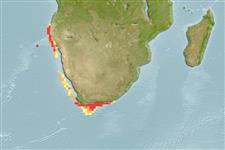Preferred temperature (Ref.
115969): 10.2 - 16.7, mean 13.7 (based on 40 cells).
Phylogenetic diversity index (Ref.
82804): PD
50 = 0.5020 [Uniqueness, from 0.5 = low to 2.0 = high].
Bayesian length-weight: a=0.00457 (0.00213 - 0.00980), b=3.12 (2.95 - 3.29), in cm Total Length, based on LWR estimates for this Genus-body shape (Ref.
93245).
Mức dinh dưỡng (Ref.
69278): 3.0 ±0.1 se; based on size and trophs of closest relatives
Thích nghi nhanh (Ref.
120179): Chiêù cao, thời gian nhân đôi của chủng quần tối thiểu là dưới 15 tháng (Preliminary K or Fecundity.).
Prior r = 0.42, 95% CL = 0.28 - 0.64, Based on 2 full stock assessments.
Fishing Vulnerability (Ref.
59153): Low vulnerability (11 of 100).
Climate Vulnerability (Ref.
125649): Low to moderate vulnerability (26 of 100).
